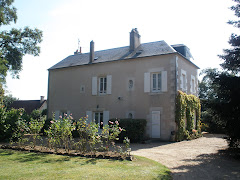


I'm not sure when I began to love tea. Certainly not when I was a child-- much like coffee, it was one of those very "adult" substances to which not nearly enough sugar could be added to make it drinkable. The bitterness of tea seemed a mysterious paradox to me. How could this liquid, which I associated with nice old ladies and frilly doilies, cut so directly to the deepest reaches of my tastebuds, triggering a reaction of such profound disgust? Whenever it was that I came to love tea (perhaps is was over the course of an adolescence spent drinking iced tea in the South?), present signs show no prospect of a withering of the flame of passion. A good cup of tea provides the strength to surmount any problems. Posing a challenge in itself, there's the restraint required to wait until the water no longer burns the tongue. Yet once the tea reaches a drinkable teaxture, the cooling process happens with a speed just as rapid, if not exponentially moreso. This means that after waiting patiently, one must precipitate-- gracefully, bien entendu (well understood)-- on one's cup so that one can drink the tea before it becomes icy. En outre (otherwise), the healing properties of the tea leaves themselves have been carefully observed by many cultures around the world.
Tea as a substance is of course an undeniably important part of human existance, and tea culture witnesses that. In Carlisle where I used to live, the recreational interest in colonial history had given rise to an antique-style tea parlor, Camelia's Sin, complete with oversized and outrageous hats that gave a nod to our postmodern American desire for anachronism. When I lived in Toulouse, Brititsh-style tea parlors abounded, as the French in general but Toulousains in particular had an obsession for British culture. At these parlors, instead of the full high-tea lunch that Camelia's Sin offered, there were never-ending tea menus and a short list of high-quality cakes to eat as an afternoon treat. Other towns I have visited have offered their own interpretation of tea culture, and many friends have shared their personal tea rituals with me.
In Nevers, I learned recently that tea plays into the role of high society dames bourgeoises (upper class ladies). The one American teacher at my lycée told me that in her husband's social circle, nice ladies didn't work, rather they sat around and drank tea while finishing their darning. Tea is, after all, a much more respectable boisson à consumer (drink to consume) than wine or Coke, of all things. This estimation explains the allure of the tea parlor in Nevers, called En Apar-thé. The tea parlor, which is juste à côté de (right next to) the Porte de Paris, the large arc that leads into the downtown from La Place de la Résistance, is decorated not necessarily in antiques, but certainly in overly-femenine bourgois-bohème (shabby chic) baubles. A large chanedelier hangs over a central table. Ecclectic chairs are grouped around many round groupings, creating an intimate, if not a bit crowded, atmosphere. The clientele is divided between a majority of elderly ladies and usually one table with a mother and daughter. It seems that the women who frequent the parlor have a high consideration for their appearance and are always well-dressed when visiting. Although I haven't seen any darning pulled out of sacs (bags or purses), it wouldn't really surprise me, and I'm sure that one of these winter afternoons I myself will have a knitting project in hand.
En Apar-thé has become somewhat of a destination for my friend Emma and me. We've been there maybe three times already, and the almost exhorbitant price of 3.50 for a pot of tea plus 4.20 for a slice of cake so far hasn't deterred us. I appreciate the salon's numerous green tea offerings, many of which have floral petals or fruit rinds mixed in. Emma's favorite is the Esprit de noël, with almond and spices, and which she has commandé (ordered) all three times we've been. Côté déssert (On the dessert side), En Apar-thé has a simple list of mostly classic french gâteaux (cakes), including mouelleux au chocolat, quatre quarts, and gâteau au noisettes. I've tried a few, and they're all delicious. Served on floral china with a tiny spoon or fork, they certainly invite dainty table manners, and polite conversation. That is, if the people in the parlor understand what you're saying...
All of this to say that on a rainy, grey afternoon in Nevers (where? really?), don't despair, stop in for a cup of tea and une bonne part de gâteau (a good serving of cake), et, bien sûr, de la discussion avec de bonnes copines (and, of course, good conversation with good (girl)friends).
Gros, gros bisous !



Clever camelliac orthography, Megan. Thanks for the post!
ReplyDeleteI think you need to submit it to a magazine!
ReplyDeleteLove Aunt Trish
PS What's the French equivalent of Thanksgiving?